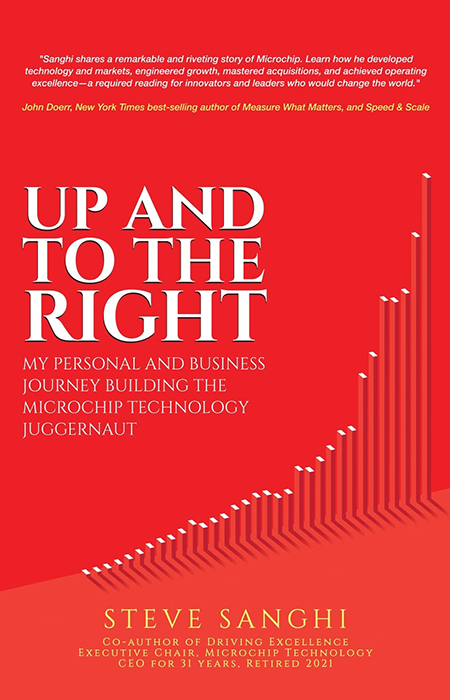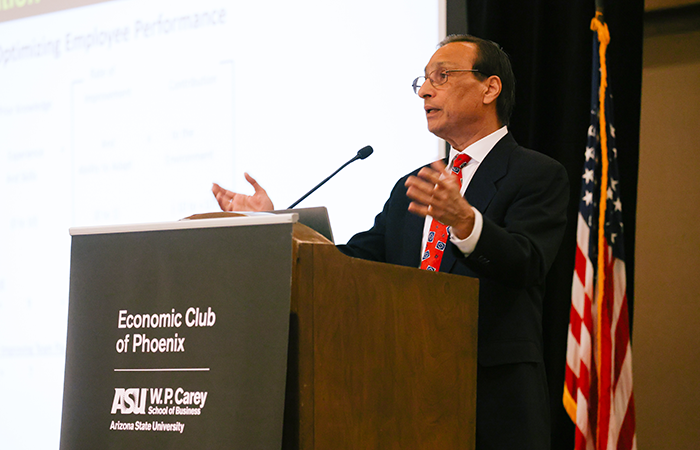Revolutionizing Business: Impinj Chair Steve Sanghi Shares His Secrets
In his new book, “Up and to the Right,” Impinj chair Steve Sanghi talks about microcontrollers, hotel coffee makers, and why people matter in management.
Steve Sanghi, the founder and former longtime-CEO (now executive chair) of semiconductor supplier Microchip Technology, recently published a book, “Up and to the Right: My Personal and Business Journey Building the Microchip Juggernaut.” It tells the story of how Microchip Technology went from a floundering semiconductor company headed toward bankruptcy to a powerhouse with a market capitalization of over $43 billion.
But the real story is how Sanghi and his unique management style made it happen. In his 30 years at the helm, Sanghi focused first on Microchip Technology’s people, emphasizing inclusion, shared rewards, innovation, trust, and communication — a leadership approach he says was ahead of its time.

Sanghi joined the Impinj board of directors in March 2021 and has served as our board chair since 2022. I recently had the opportunity to ask Sanghi a few questions about his new book, what his childhood was like growing up in India, and why his management style should serve as a blueprint for the way companies are run.
Q: In your book, you talk about your life growing up in India. What did you learn in these formative years that brought you to where you are today?
A: Taking things apart and studying how they worked sparked my early interest in science and technology. I once took apart a wall clock to see why and how it worked — and was not able to put it back together in a functional way. This interest did not go away as I progressed in my career. I used to travel with a small kit of tools and open thermostats, coffee makers, and other appliances in hotel rooms around the world to see if they had Microchip Technology’s microcontrollers inside. I stopped doing that in the post-9/11 world.
Q: During your time at Microchip Technology, you oversaw the transformation of your company from tough times to revenues of more than $8 billion per year. What helped you carry on through the challenges?
A: I had a vision that field-programmable microcontrollers could change the ROM-based microcontroller industry the same way as field-programmable gate arrays changed the gate array industry. I rallied my team, the board, and the investors around that vision. The employees and I made significant sacrifices in the early years to keep the company alive. As the company’s products were gaining traction in the marketplace, I found it got easier to sell the vision. Microchip Technology went public in March 1993, two short years after a near-washout financing round. The stock price increased six-fold in our first year as a public company and is 300 times higher today than it was at its IPO 30 years ago.
Q: You have faced many leadership challenges: funding, competition, and market dynamics. Can you share your approach to first identifying a challenge and then addressing it?
A: My approach is seeing a challenge very directly: no wish-wash, no sweeping it under the rug, no “I don’t see it,” no “what I don’t see won’t hurt me.” I grab the bull by its horns, then put a plan together to deal with it. Basically, I look at how I can gain an advantage out of every challenge and every crisis.

When the challenge was funding, Microchip Technology put a business plan together and marketed it to venture capitalists around the country. When the challenge was competition, the company created better products that left the competition in the dust. Microchip Technology also partnered with third-party design tool providers — entities that our counterparts saw as competition. We offered them our emulators, qualified their tools, and listed them on our website. We lost out on small-tools revenue, but we made up for it 100 times over in the sale of microcontrollers.
Q: Can you tell me how you think about the role of a leader in creating a positive workplace culture?
A: A company culture is one of the most important assets for a company. At Microchip Technology, we have very few rules except the ones required by the governments. The rest of the business is conducted by values. We put a lot of trust in our employees to make decisions that affect our customers. They are empowered to make executive decisions based on Microchip Technology’s values. This accelerates the pace of our decision-making and is often critical in a highly competitive marketplace.
Q: You were immensely successful in saving Microchip Technology from bankruptcy when you took over as CEO. If you could give one piece of advice to a struggling or emerging company, what would it be?
A: The advice would be to evaluate the “NABCM” of your business:
- N stands for market need. If your product is not satisfying an unmet market need, then it will become an expensive hobby and won’t go anywhere.
- A stands for your approach to meeting the market need. What is your technology? How do you go to market? Is your business domestic or global? Do you use distributors? Do you use value-added resellers?
- B stands for benefits-per-cost of your approach. There is always a prevailing solution. If your product is superior in performance but costs more, the benefits-per-cost had better be significant.
- C stands for competition. What are your competitors doing? What is their approach and benefits-per-cost of their approach?
- M stands for management. I will dissect the management team, look at their experience, motivation, skin in the game, and similar qualities.
You can read more about Sanghi’s personal and corporate journey in his book, “Up and to the Right,” available for purchase on Amazon. To learn more about RAIN RFID and the Impinj platform, view the latest from the Impinj blog.
Thursday, September 28, 2023
ABOUT THE AUTHOR

Gaylene Meyer
Impinj Vice President of Global Marketing and Communications
Gaylene Meyer leads a team focused on delivering world-class marketing and communications that engage partners and customers worldwide.
Sign Up for the latest news
